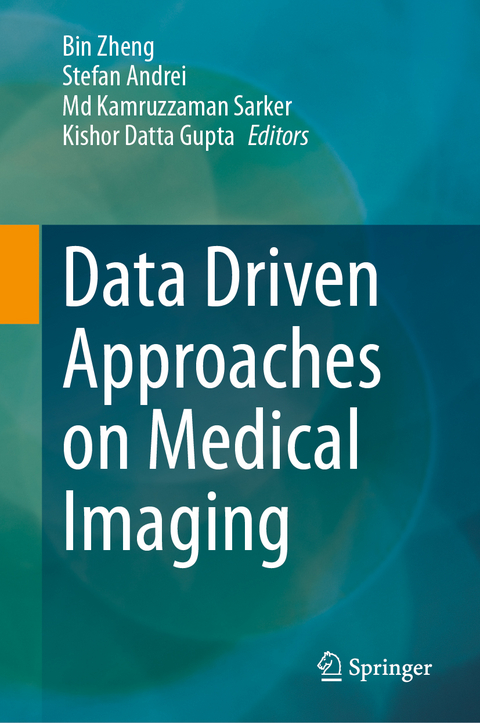
Data Driven Approaches on Medical Imaging
Springer International Publishing (Verlag)
978-3-031-47771-3 (ISBN)
This book deals with the recent advancements in computer vision techniques such as active learning, few-shot learning, zero shot learning, explainable and interpretable ML, online learning, AutoML etc. and their applications in medical domain. Moreover, the key challenges which affect the design, development, and performance of medical imaging systems are addressed. In addition, the state-of-the-art medical imaging methodologies for efficient, interpretable, explainable, and practical implementation of computer imaging techniques are discussed. At present, there are no textbook resources that address the medical imaging technologies. There are ongoing and novel research outcomes which would be useful for the development of novel medical imaging technologies/processes/equipment which can improve the current state of the art.
The book particularly focuses on the use of data driven new technologies on medical imaging vision such as Active learning, Online learning, few shot learning, AutoML, segmentation etc.
lt;p>Dr. Bin Zheng received his PhD degree from the Department of Electrical Engineering, University of Delaware in 1993. After working in the Medical Imaging Research Division, Department of Radiology, University of Pittsburgh, for 20 years, he joined faculty of the School of Electrical and Computer Engineering, University of Oklahoma in 2013. Currently, he is a Gerald Tuma Presidential Professor and a Director of Oklahoma Center of Medical Imaging for Translational Cancer Research. He is also a fellow of American Institute for Medicine and Biological Engineering (AIMBE) and an editor-in-chief of Journal of X-ray Science and Technology. He works in the field of quantitative medical image feature processing and analysis. His research interest focuses on developing and evaluating (1) new image processing algorithms to detect suspicious diseases (cancer and stroke), (2) image feature based machine learning models to predict disease risk, identify malignant tumors, and assess patient prognosis or treatment efficacy, and (3) interactive computer-aided diagnosis systems using the content-based image retrieval technology to provide radiologists "visual-aided tools" in reading and interpreting medical images. He has co-authored over 210 referred journal papers in medical imaging research field with a current Google Scholar H-index of 54.
Dr. Stefan Andrei received his PhD from Hamburg University, Germany, in 2000 as a World Bank Scholarship Japan Graduate student. He is currently a Professor of Department of Computer Science with Oregon Institute of Technology, Previously he was chair of computer science department in Lamar University. He has already been a co-author of more than 100 peer reviewed papers at international reputable journals and conferences. His research interests include real-time embedded systems, computer vision, software engineering, and more.
Dr. Md Kamruzzaman Sarker is working as a tenure track assistant professor at the department of Computing Sciences at the Bowie State University. He obtained his PhD in computer science with focus on Artificial Intelligence in 2020 from Kansas State University. After his PhD he also worked as a postdoc at the Center for Artificial Intelligence and Data Science of the Same university. He obtained his M.S. in Computer Science in 2018 from Wright State University and B.Sc. in Computer Science and Engineering from Khulna University of Engineering & Technology. He also worked at Intel Corporation and Samsung Electronics. He has authored more than 30 peer reviewed papers and edited a book.
Dr. Kishor Datta Gupta is working as a tenure track assistant professor at the Clark Atlanta University. He obtained his PhD in computer science with focus on Artificial Intelligence in 2021 from University of Memphis. He has authored more than 30 peer reviewed papers and co-invented a patent. His research interest include medical data imaging and security, HIPPA compliant medical data processing etc.
Chapter. 1. Introduction of Medical Imaging Modalities.- Chapter. 2. Introduction to Medical Imaging Informatics.- Chapter. 3. Active Learning on Medical Image.- Chapter. 4. Few Shot Learning for Medical Imaging: A Comparative Analysis of Methodologies and Formal Mathematical Framework.- Chapter. 5. AUTOML Systems for Medical Imaging.- Chapter. 6. Online learning for X-ray, CT or MRI.- Chapter. 7. Invariant Scattering Transform for Medical Imaging.- Chapter. 8. Generative Adversarial Networks for Data Augmentation.- Chapter. 9. Bias, Ethical concerns, and explainable decision-making in medical imaging research.- Chapter. 10. Case Studies on X-Ray Imaging, MRI and Nuclear Imaging.- Index.
| Erscheinungsdatum | 05.02.2024 |
|---|---|
| Zusatzinfo | XV, 228 p. 75 illus., 54 illus. in color. |
| Verlagsort | Cham |
| Sprache | englisch |
| Maße | 155 x 235 mm |
| Gewicht | 523 g |
| Themenwelt | Mathematik / Informatik ► Informatik |
| Technik ► Elektrotechnik / Energietechnik | |
| Schlagworte | CNN • computer vision • CT scan • Few shot learning • generative adversarial networks • Medical Diagnosis • Medical Imaging • Medical imaging informatics • MRI • X Ray |
| ISBN-10 | 3-031-47771-5 / 3031477715 |
| ISBN-13 | 978-3-031-47771-3 / 9783031477713 |
| Zustand | Neuware |
| Haben Sie eine Frage zum Produkt? |
aus dem Bereich


